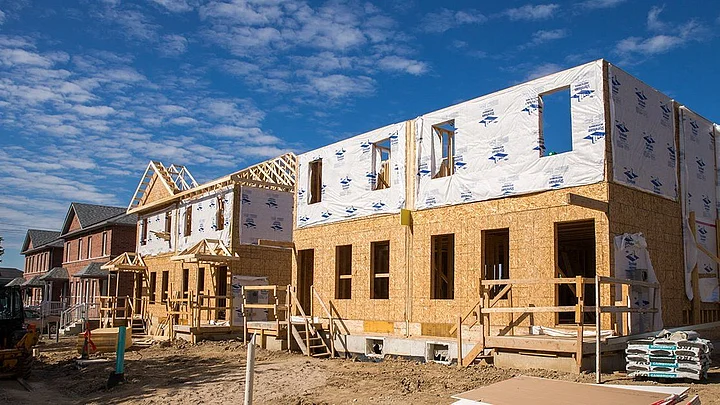Few topics during the federal election campaign have garnered more attention than high house prices and a lack of housing affordability. Both Conservatives and Liberals say a major problem is a lack of housing supply. To address the issue, they promise to build millions of additional houses.
Contrary to popular belief, high house prices are not due to supply shortages. The COVID-19 pandemic should have made this clear. Despite the slowest population growth since the First World War, and the most number of houses built in more than a decade, prices went up 27 percent.
The recent spike in prices is no mere historical blip. Since 2000, prices have risen 160 percent in inflation-adjusted dollars.
Meanwhile, the supply of housing has grown in lockstep with new households, even as average household sizes have fallen.
According to reports by both the International Monetary Fund and the Parliamentary Budget Office of Canada, new housing completions have actually exceeded household growth for most of the 21st century, leading to historically high vacancy rates.
House Prices are Asset Prices
To understand the dynamics of housing markets, we need to distinguish between two prices: the price of owning a house, and the price of renting it.
Rental prices represent the economic cost of living in a house. Like any other commodity, rent prices change, at least in theory, according to demand and supply.
In contrast, house prices are asset prices. According to standard economic theory, they are determined by their future earnings, adjusted for risk.
You can think of the earnings of home ownership along the same lines as the earnings of any business: they are the difference between revenues and costs.
For landlords, revenues take the form of monthly rental payments. For owners/occupiers, they take the form of savings earned from not paying rent, or what are known as imputed rents. Imputed rents are included in GDP calculations.
In some countries, like the Netherlands and Switzerland, they are even treated as taxable income.
The costs of ownership include depreciation, maintenance, property taxes, insurance, utilities and monthly interest payments. Note how mortgage principal payments are not a cost. That’s because they increase homeowners’ equity. They are a form of savings.
If the earnings of home ownership go up — due to rising revenues, falling costs, or both — then house prices should rise. With this framework in mind, we can now try and identify big changes that might account for skyrocketing prices.
In recent years, rental prices have surpassed the rate of inflation, especially in major cities. But house prices have risen much, much faster than rent. Why?
Falling Interest Rates Drive Up Prices
Recall the costs of ownership. Specifically, decades of falling interest rates have lowered the cost of borrowing a mortgage.
In the 1980s, rates on a conventional mortgage were 18 per cent. Today, they are closer to two to three per cent — less than inflation. Every time borrowing costs fall, the earnings of home ownership go up.
The result is predictable: buyers bid up prices and take on more debt. The same logic applies to incentives for first-time buyers.
By lowering the cost of ownership, these policies contribute to the very problem they’re trying to solve: higher house prices.
While falling borrowing costs increase the earnings of home ownership, we also have to adjust these earnings for risk.
In recent decades, declining returns on “risk-free” government bonds — a crucial benchmark in financial markets — has incentivized investors of all sorts to put their money into riskier assets, especially real estate.
According to the Bank of England, almost all the growth in house prices relative to rents (and incomes) can be explained by 35 years of unexpected declines in the risk-free rate of interest.
Of course, interest rates are not the only factor behind rising prices. A government-supported, mortgage-backed security program, tax subsidies and incentives for homeowners, money-laundering through real estate, along with speculative frenzies in major cities, all help to explain Canada’s exceptional rate of house price growth.
More Supply is not a Solution
The supply of housing matters, too. But from an asset-model perspective, supply only affects one variable in the determination of house prices — the economic cost of housing, or rent. The fact that prices have risen far beyond rent tells us that it’s due to financial factors alone — not a lack of supply.
Finally, there’s no guarantee that more supply will even lower prices via their impact on rent. Models show that because new supply represents a small share of a large, pre-existing housing stock, even big increases in construction have relatively minor effects on prices.
Finally, if total supply increases to the extent that prices do fall, developers can always slow down the rate of new construction.
Lucky for them, land does not depreciate like other assets.
Promises to build millions of more houses make it seem as though politicians are fighting hard to keep the dream of home ownership alive. In reality, it’s not a meaningful solution. But maybe that’s the point.
Politicians know that many of their constituents are relying on high house prices to secure their retirement or pay for their kids’ tuition, so it’s unlikely they even want prices to fall.
(Joel Roberts is a PhD Candidate of Social and Political Thought at York University in Canada. This is an opinion piece and the views expressed above are the author’s own. The Quint neither endorses nor is responsible for the same.)
(This article was first published in The Conversation and republished here with permission.)
(At The Quint, we question everything. Play an active role in shaping our journalism by becoming a member today.)
